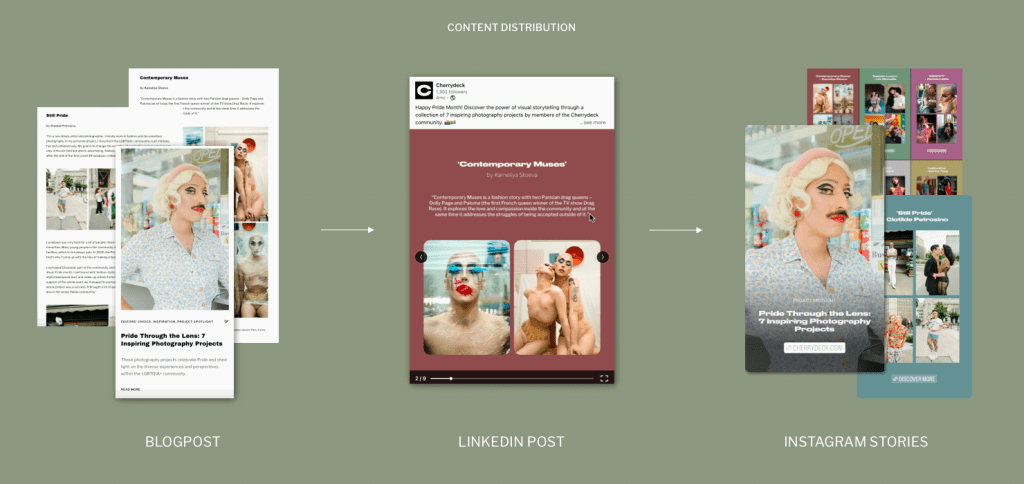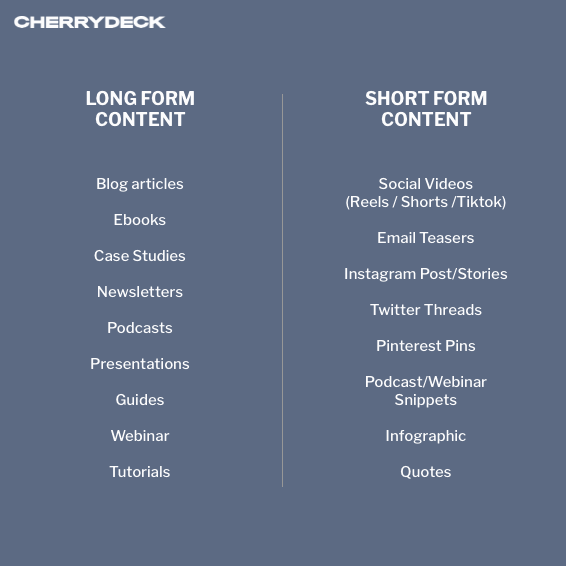Content repurposing is a key component of an effective content marketing strategy. It saves time and resources while allowing you to reach your target audience in different channels. Learn how to repurpose your content in this guide!
Content marketing not only provides value for a company in that it serves to market their brand and can be used as one of many lead generation strategies. Creating quality content enables you to position yourself as an industry authority and knowledge stronghold.
You no longer only provide the product or service you advertise, but also the service of offering information and educating customers about the industry.
However, as with anything, there’s a price that comes with quality. Creating content is a time-consuming process and can be expensive – particularly if you outsource creation to freelancers.
Consistently producing content as your key marketing strategy is an expensive and expansive workload to undertake, so learning how you can repurpose your content can be a huge game-changer.


What is content repurposing?
Repurposing content is not the same thing as changing the color of your fonts and republishing it a few months later. To repurpose content you need to give it a new form of intrinsic value. This can mean entirely reformatting the content and using it to a new end.
Time and cost efficiency are not the only benefits of content repurposing. By optimizing your content to new platforms, you can improve the SEO of your marketing content as well as target audiences more directly. Also, if you pay a close eye to content marketing metrics, you will know what content has long-term value and can be reused, giving you more bang for your buck.
For example, you could take an old customer story and turn it into a testimonial video for Instagram, Youtube, or even Tiktok. This will enable you to reach a whole new audience for the content, while not having to create original content from scratch.
Questions to ask yourself before you reuse your content
As with any marketing strategy, going into it blindly is never the most effective method. Before you get started, you need to have a plan in place. Ask yourself the questions below to begin preparing for your repurposing strategy.
What do you want to get out of it?
The best goals are quantifiable, and marketing is no different. Every company’s goal will be different, be it to gain a larger social media following, to increase sales of a particular product, or to generate more leads.
Having a clear objective helps discussions among the marketing team become far more effective, and will be reflected in the seamlessness of your content repurposing when exploring an effective communication solution.
What content do you already have?
Turn back to your content marketing metrics and consider what content you have that has been most successful and will repurpose effectively. It’s also very important that you have a robust organizational foundation for content to simplify this process.
For example, if you were a communications provider with content on “examples of customer obsession” in the context of (then) cutting-edge technology, it’s most likely outdated now as the technology moves on so quickly.
On the other hand, evergreen articles can be repurposed into different forms of content such as infographics and video.

What is the competition doing?
This is a more general question to ask before any marketing strategy, but it deserves reiteration. Humans learn from experience, and a risk-free way of doing this is by relying on the experience of others.
Your direct competition will likely be marketing on similar platforms as you, and this can be used for inspiration, or to help drive ideas that will make your strategy unique.
You can also look at the feedback from the public engaging with posts to judge how successful a piece of content has been. Just as you consider internal feedback on your enterprise transformation strategy, you can base your content repurposing upon customer behaviors.
This should not only be applied to your competition’s content but also your own, as past feedback on your own posts can be extremely useful in directing new strategies.
What platform will you use?
Don’t make the mistake of choosing the platform as an afterthought — it’s as vital as the ‘.ai’ domain you might choose to mark your business out as a market leader in AI.
As previously mentioned, content repurposing can be great for the sheer reason that it enables you to optimize posts and improve their SEO ranking, particularly if you spend time improving digital accessibility.
This applies to both the platform you intend to post content to and the platforms you intend to market the content on. These choices cause significant variations in strategy beforehand. For example, marketing on TikTok compared to X (former Twitter) will likely lead to entirely different and unique formatting being used.

Ideas for content repurposing
Still struggling to get your head around content repurposing? Or, perhaps you’re lacking inspiration? Let’s go through some ideas to get the creative juices flowing.
Video
Video content is a consistently useful element of a content repurposing marketing strategy. It’s eye-catching, particularly in an age where much of our time spent on social media is used scrolling aimlessly.
So, how could you repurpose content for video?
Easy! You could take data from previous blog posts where research was conducted, and produce a short and informative video.
You could even take a webinar and edit or transform it into a tutorial. For example, a webinar on how to measure the SEO value of your content could be an engaging video for a target audience of marketers.
Webinars can also make great short clips or “highlights” that you can post, making the most out of the content you already have and more accessible for people on the go.
Images
Creating visual content is a reliable go-to. Previous content can be recreated into infographics with ease, which can be posted in downloadable forms to help you keep an eye on any successfully generated leads.
These infographics can also be optimized for social media posts, giving you yet another use for your visual creations. Alternatively, you can add text such as fun facts, statistics, etc to already-existing photos of your products.
There are different elements you would want to consider when it comes to optimizing for different platforms. For example, ensure your photos and videos fit the right ratios according to the requirements of your chosen platform (i.e. Instagram, Pinterest, Tiktok).

Audio
Do you listen to any podcasts? Odds are that you do. The past few years have really been the podcast boom and for good reason. People are increasingly busy, and multitasking is the new norm. Podcasts enable you to work, work out, cook, wash, do chores, and do many more things while simultaneously consuming the content you love.
An easy way to repurpose content could be using the audio from webinars or interviews conducted as previous pieces of content, and editing it into a stimulating podcast. This is a great way to keep up with evolving content trends and requires limited reworking of the content as generally, webinars are easily transferable.


Written
Reusing written content is super simple. Have a listicle that was previously posted as a blog post? Transform it into an X (former Twitter) thread!
Alternatively, if you have some recurring themes that your content tends to cover, this could be a great opportunity to combine them into downloadable ebooks. These products can be of extremely high value to your customers as they contain essential industry knowledge in a single location. You may also be able to attract sponsors from other companies for your ebooks, which can add to their monetary value.
Alternatively, written content could be in the form of “write-ups”. After hosting webinars, podcasts, or any other kind of content, a short snappy article can be written about the event. This will gain organic reads of its own, but can also encourage others to go on and consume your other pieces of content. With a variety of content on your site, it can begin to work together as one homogenous piece of work.


Let’s Sum It Up
Reusing content is really simple once you’ve taken a step back and evaluated the content already accessible. Check what your new goal is, and how you are going to get there. Ask yourself the following questions:
- What do you want to get out of it?
- What content do you already have?
- What is the competition doing?
- What platform will you use?
Key things to remember are optimizing for the platform, and working towards your target audience. Remember, business professionals will probably not find your consultancy service on TikTok.
With a dedicated content marketing strategy at hand, nothing can stop you from increasing the value of hard work already done.


